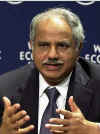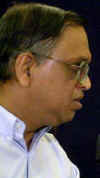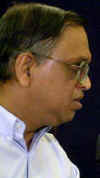|
|
||||
|
Role of
Internet In South Asian Development Technology
- a weapon to
Viewpoint Sundown Madness at Wagah Border
Heritage & Travel
Books
|
|
|
||
|
the-south-asian.com February 2001 |
||||
|
South Asians quoted - on Digital divide or digital opportunity?
Digital facts
The information revolution, particularly the Internet, is redefining the way people work and think. There is certainly a digital divide that exists, but the same technology has also been harnessed to reduce the divide and create more economic opportunities for the rural poor of the world - most of whom live in South Asia. Iqbal Quadir pioneered the way in which telecommunications empowered the rural women of Bangladesh. There have been many more success stories of local initiative. The lessons so far have been that technology can also be used to reduce disparity between the rich and the poor - both at the macro and individual level. "The consensus is that both the market and the state will play important roles in closing the divide, as will partnerships between the private and public sectors." Three factors that will broadly determine how digital opportunities can be created, are: access to technology, availability of high-quality content for potential users in less-developed nations and communities, and efforts to improve living standards and literacy rates. Can technology alleviate poverty?
Will the Internet Make the Notion of Perfect Market Competition Real? Masood Jabbar, President, Computer Systems, Sun Microsystems, USA "I came in here with the firm conviction that dynamic pricing is here and that we should get on with it," he said. "Yet while the concept is there, it appears that it is not quite ready for prime time." French consumers are very particular about their food, for example, and like to be able to handle and smell their produce at the corner market. B2B Exchanges: Who Really Wins? Mohanbir Sawhney, Professor of Electronic Commerce and Technology, Kellogg Graduate School of Management, Northwestern University, USA. "Last year, everyone considered it a unique time in history. However, history showed that the striking characteristic about times like these "is that there have been other times like these," Sawhney noted. Today B2B looks very much like earlier grids, whether telephones, electricity or the highways system. The interesting point about them is their impact on business, and most of the added value moved downstream to the customer. Now people are asking: "Is frictionless commerce going to lead to profitless commerce?" Another striking trend in the past 12 months has been towards collaboration among competitors. "As someone observed, the last big consortium was
Communism and that didn’t quite work out," Sawhney observed. "The thing I like about B2B is that I can be a futurist and a historian in the same year."
E-Government: The Next Revolution? N. Chandrababu Naidu, Chief Minister of Andhra Pradesh, India, reported on the great improvements in accountability, speed and efficiency achieved in state services. George Pataki, Governor of New York, USA, mentioned analysis of crime patterns across jurisdictional lines to improve crime-fighting techniques as an example of how the new technology could improve government services.
Corporate decision-making and leadership
|
||||
| Copyright © 2000 [the-south-asian.com]. Intellectual Property. All rights reserved. | ||||
| Home |


